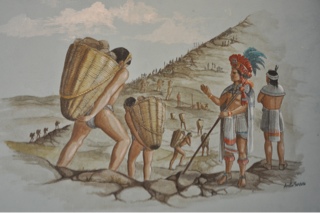Sometime around 750 CE the inhabitants of this city burnt down their houses and left the area. It happened after 10 year drought and both the inhabitants and their rulers believed they had wronged their gods.
You can walk around in the rooms bordered by the remaining stone walls.
Just as in Knossos on the island of Crete, the surrounding dwellings had an elaborate underground system of pipes to transport water.
Archeologists haven't discovered tombs in the Pyramids of the Sun and Moon.. But in the Sun Pyramid they found a tunnel leading to a cave with four petal- like sections formed around a circle. It was here that the bones of many children were found. They were sacrificed to the gods. You'll see a photo below of a bas relief of this design that figures in much of the indigenous people's art.
I felt emotional seeing the tiny figures these peoples produced. They are so precious and finely wrought. Some of the photos below are from the Museum of Archeology in Mexico City and others from the Amparo Museum in Puebla.
You'll see an artist's conception of of a market near a pyramid. A man is flattening paper for sale. The woman is selling jewelry. In another photo you can see how the pyramids were constructed on the backs of men.
We have technology -- but these peoples who lived so long ago, brutal as theirs lives seem to us now, were incredibly advanced in their workmanship and thought.
You'll see a painting of a competition between two men. Can you imagine that the victor of the game might have had the honour of being sacrificed to the gods?









No comments:
Post a Comment